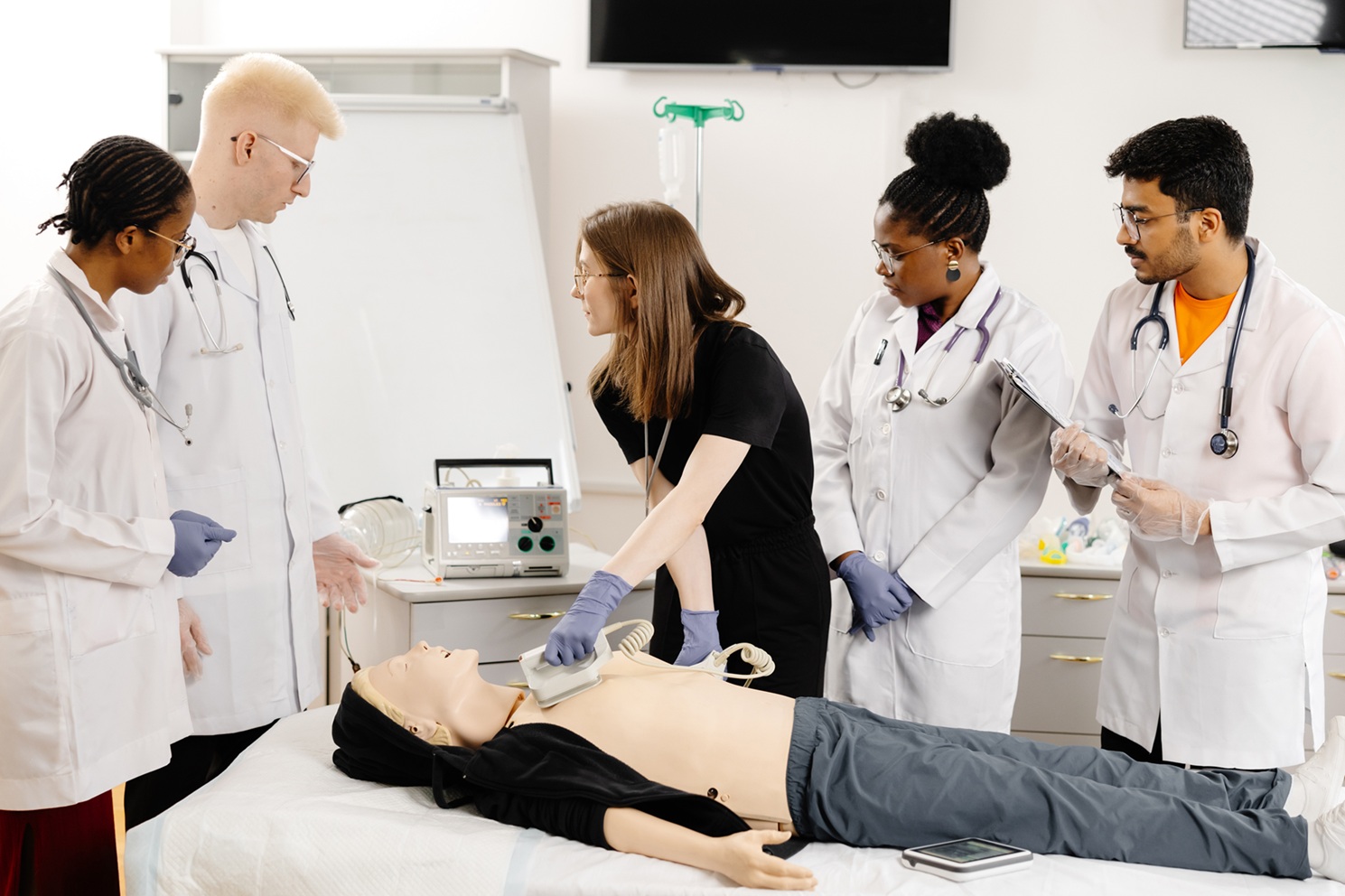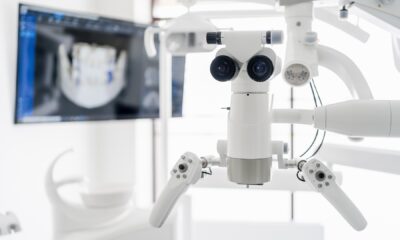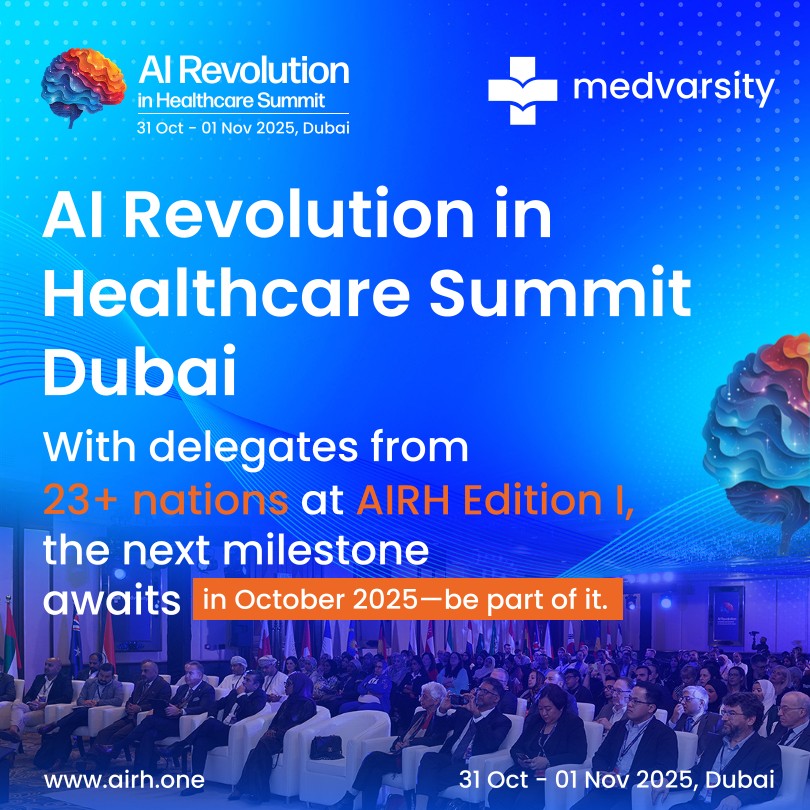Artificial Intelligence
How AI is Revolutionizing Medical Education and Training

Introduction
Artificial Intelligence (AI) is transforming the field of medical education and training, bringing a new era of interactive learning, personalized education, and advanced simulation technologies. Traditionally, medical training relied on textbooks, cadaver dissections, and hands-on clinical experience. While these methods remain essential, AI-powered innovations are enhancing medical education by providing real-time feedback, predictive learning, and immersive simulations.
With AI-driven tools such as virtual reality (VR) simulations, chatbots, AI tutors, and machine learning-powered diagnostics, medical students and professionals can develop better decision-making skills, clinical expertise, and personalized learning experiences. This article explores how AI is revolutionizing medical education, the benefits of AI-driven training, and its future impact on healthcare learning.
The Role of AI in Modern Medical Education
AI is transforming how medical students and professionals acquire knowledge and refine their skills. Here are some of the key areas where AI is making a significant impact:
1. Personalized Learning with AI-Powered Tutors
- AI-driven adaptive learning platforms analyze students’ strengths and weaknesses, tailoring coursework to individual needs.
- Intelligent tutoring systems provide personalized explanations, quizzes, and feedback based on a student’s performance.
- AI chatbots like ChatGPT and IBM Watson assist medical students by answering complex medical queries in real-time.
2. AI in Clinical Simulations and Virtual Reality (VR) Training
- AI-powered virtual patients simulate real-life symptoms, allowing students to practice diagnosis and treatment strategies.
- VR-based surgical simulations help medical professionals refine their skills in a risk-free, immersive environment.
- AI-enhanced haptic feedback systems provide realistic sensations of tissue resistance and organ manipulation.
Example: Osso VR and Touch Surgery are AI-driven surgical training platforms that allow trainees to practice complex procedures in a virtual setting.
3. AI-Powered Medical Diagnosis Training
- AI algorithms analyze X-rays, MRIs, and pathology slides, training medical students to identify diseases with greater accuracy.
- Machine learning models predict disease progression, helping doctors refine their diagnostic skills.
- AI-based decision support systems (CDSS) guide students through clinical decision-making processes.
Example: AI-assisted diagnostic tools like Google’s DeepMind and IBM Watson Health are improving the accuracy of medical education by analyzing vast datasets.
4. AI for Automating Medical Research and Literature Review
- AI speeds up medical literature analysis, summarizing key findings from thousands of research papers.
- AI-powered search engines, like Semantic Scholar and PubMed GPT, assist students in accessing relevant medical studies efficiently.
- AI tools help medical researchers identify patterns in clinical data, leading to faster discoveries.
The Benefits of AI in Medical Training
1. Increased Accessibility to Medical Education
- AI-based platforms make medical training available globally, allowing students in remote areas to access high-quality learning materials.
- AI-powered language translation tools break down language barriers, enabling medical knowledge to be shared worldwide.
2. Enhanced Hands-On Experience with Virtual Patients
- AI-driven simulations replicate rare medical cases, providing students with exposure to conditions they might not frequently encounter.
- Virtual reality (VR) surgical training programs help young surgeons practice without the need for human patients.
3. Faster Skill Acquisition and Real-Time Feedback
- AI tracks a student’s progress and suggests personalized improvements based on performance data.
- Real-time AI feedback helps trainees correct mistakes immediately, improving learning efficiency.
4. Reduced Medical Errors and Improved Decision-Making
- AI-driven clinical decision support systems (CDSS) help trainees practice evidence-based medicine.
- AI simulations help medical professionals understand the consequences of diagnostic errors, improving patient safety.
Challenges of AI in Medical Education
Despite its advantages, integrating AI into medical training faces challenges:
1. Ethical and Bias Issues in AI Algorithms
- AI models may inherit biases from historical medical data, leading to inaccurate predictions.
- Ethical concerns arise regarding AI replacing human judgment in medical decision-making.
2. Dependence on AI and Loss of Critical Thinking Skills
- Over-reliance on AI tools may reduce clinical intuition and problem-solving abilities among medical trainees.
- Educators must balance AI-assisted learning with traditional training methods to maintain clinical reasoning skills.
3. High Implementation Costs and Digital Divide
- Developing AI-driven medical education platforms requires significant investment.
- Not all medical institutions can afford VR labs, AI tutors, or advanced simulation tools, leading to disparities in access.
4. Data Privacy and Security Concerns
- AI-driven platforms store sensitive patient data, raising cybersecurity risks.
- Healthcare institutions must ensure compliance with HIPAA, GDPR, and other data protection regulations.
The Future of AI in Medical Education and Training
As AI technology advances, the future of medical training will become even more interactive, efficient, and personalized. Some emerging trends include:
1. AI-Driven Augmented Reality (AR) for Real-Time Training
- AR headsets will allow medical students to visualize 3D anatomy models in real-time.
- AI-assisted AR guides will overlay instructions during real-life surgeries, enhancing surgical precision.
2. AI-Powered Robotic Surgery Training
- AI will enhance robot-assisted surgery training, allowing young surgeons to practice robotic procedures with real-time AI guidance.
- Haptic feedback gloves will simulate the feel of real tissue during robotic training.
3. AI in Personalized Residency Training
- AI will help match medical residents with specialized training programs based on their strengths and career interests.
- Machine learning models will predict which medical specialties students are best suited for, optimizing medical education pathways.
4. AI-Enabled Virtual Medical Conferences and Peer Learning
- AI chatbots will facilitate real-time Q&A sessions in medical webinars.
- AI-driven peer learning networks will connect students globally, promoting knowledge-sharing.
5. AI-Based Real-Time Translation for Global Medical Collaboration
- AI-powered real-time translation will allow students worldwide to collaborate on medical research and case studies, regardless of language barriers.
Conclusion
AI is revolutionizing medical education and training by enhancing learning experiences, improving skill acquisition, and making education more accessible. From AI-powered tutors and diagnostic simulations to VR surgical training, AI is transforming how medical professionals are trained and how they develop expertise.
While challenges such as ethical concerns, data privacy, and implementation costs remain, the benefits of AI-driven medical education far outweigh the drawbacks. As AI continues to evolve, it will play an even greater role in shaping the future of healthcare training, ensuring that medical professionals are better prepared to provide high-quality patient care.
Medical education is no longer confined to textbooks and lecture halls—AI is leading the way toward a smarter, more efficient, and patient-centered learning experience.
Artificial Intelligence
How AI is Transforming Telemedicine: A Post-Pandemic Revolution

The COVID-19 pandemic accelerated the adoption of telemedicine, revolutionizing the way healthcare is delivered. What was once a convenience has now become a necessity, with millions relying on virtual consultations and remote monitoring. However, the real game-changer in telemedicine is Artificial Intelligence (AI), which is enhancing efficiency, improving diagnoses, and personalizing patient care like never before.
As we navigate the post-pandemic era, AI-driven telemedicine is shaping the future of healthcare, making it more accessible, cost-effective, and patient-centric. But how exactly is AI transforming telemedicine? Let’s explore the key innovations and challenges in this rapidly evolving field.
1. AI-Powered Virtual Consultations
Virtual doctor visits have become a standard practice, but AI is taking them a step further by enhancing diagnostic capabilities and reducing physician workload.
- AI Chatbots & Virtual Assistants: AI-powered chatbots like Babylon Health and Ada Health assist patients by analyzing symptoms, offering preliminary diagnoses, and guiding them to the appropriate healthcare professional.
- Automated Medical History Collection: AI can gather patient history, summarize symptoms, and provide doctors with essential insights before a consultation, saving time and improving efficiency.
- Language Processing for Better Communication: AI-driven speech recognition ensures seamless transcription of doctor-patient conversations, reducing the burden of manual documentation.
2. Remote Patient Monitoring (RPM) with AI
With the rise of wearable health devices, AI is playing a crucial role in real-time health monitoring. Devices like smartwatches and biosensors collect continuous data on heart rate, blood pressure, oxygen levels, and glucose levels, enabling proactive healthcare interventions.
- Predictive Analytics for Chronic Disease Management: AI analyzes patient data to predict potential health risks, allowing doctors to intervene before conditions worsen.
- AI-Powered ECG and Blood Pressure Monitoring: Devices like the Apple Watch and Fitbit now incorporate AI-driven algorithms to detect irregular heartbeats, alerting users to possible atrial fibrillation or hypertension.
- Smart AI Alerts: AI flags abnormalities and sends automated alerts to physicians, caregivers, or emergency responders, enhancing patient safety.
3. AI-Based Diagnostics in Telemedicine
One of the biggest challenges in virtual healthcare is accurate remote diagnosis. AI is bridging this gap with advanced image recognition, deep learning models, and intelligent symptom analysis.
- AI-Driven Radiology & Imaging: AI can analyze medical scans (X-rays, MRIs, and CT scans) remotely, assisting radiologists in identifying diseases like pneumonia, cancer, and fractures faster and more accurately.
- Computer Vision for Dermatology & Ophthalmology: Telemedicine platforms now use AI to analyze skin conditions and eye diseases through smartphone images, reducing the need for in-person visits.
- AI for Early Disease Detection: Machine learning models trained on vast datasets can detect early signs of conditions like diabetes, Alzheimer’s, and respiratory illnesses, allowing for timely intervention.
4. AI and Personalized Treatment Plans
Every patient is unique, and AI is making personalized medicine a reality. By analyzing individual health records, genetics, and lifestyle factors, AI can tailor treatment recommendations specifically for each patient.
- AI-Driven Medication Management: AI suggests optimal drug dosages and treatment plans based on patient history and genetic data, reducing adverse drug reactions.
- Behavioral Health & AI in Mental Health Teletherapy: AI chatbots like Woebot and Wysa provide mental health support, offering cognitive behavioral therapy (CBT) exercises, emotional tracking, and crisis intervention.
- AI-Enhanced Nutrition and Wellness Coaching: AI-powered apps analyze diet, exercise, and sleep patterns, offering personalized health recommendations to improve overall well-being.
5. Reducing Healthcare Disparities with AI Telemedicine
AI-driven telemedicine is bridging the gap in healthcare access, especially in rural and underserved areas.
- Language Translation & Accessibility Features: AI-powered translation tools enable cross-language communication, allowing doctors to consult with patients who speak different languages.
- AI-Powered Diagnostics for Low-Resource Areas: In regions with limited healthcare facilities, AI-based mobile health apps help detect diseases early, ensuring prompt treatment.
- Affordable AI-Driven Healthcare: Virtual AI consultations reduce the cost of healthcare, making medical advice more accessible to individuals without insurance or financial means.
6. Challenges and Ethical Concerns in AI Telemedicine
While AI is revolutionizing telemedicine, there are several challenges that need to be addressed:
- Data Privacy & Security Risks: AI-driven telemedicine relies on massive amounts of sensitive patient data. Ensuring secure storage, encryption, and compliance with HIPAA and GDPR regulations is crucial.
- Bias in AI Algorithms: AI models must be trained on diverse datasets to avoid racial, gender, and socioeconomic biases that can lead to misdiagnoses and health disparities.
- Lack of Human Touch: While AI enhances efficiency, some patients may feel uncomfortable relying on automated chatbots or virtual assistants instead of human doctors. Balancing AI automation with human empathy is essential.
- Regulatory Approvals and Legal Liability: Who is responsible if an AI-driven diagnosis leads to medical errors? Governments and healthcare organizations must establish clear legal guidelines for AI accountability.
The Future of AI in Telemedicine
The post-pandemic era has proven that AI-driven telemedicine is here to stay. As technology advances, we can expect:
- Fully AI-Assisted Remote Surgeries using 5G, robotics, and augmented reality.
- Advanced AI Health Predictors that forecast potential diseases years in advance based on genetic and lifestyle data.
- AI-Integrated Smart Homes that continuously monitor patient health through IoT-connected devices, ensuring early intervention.
AI is not replacing doctors—instead, it is enhancing their capabilities, allowing healthcare providers to deliver faster, more accurate, and more personalized care. The future of telemedicine lies in a seamless collaboration between AI technology and human expertise, ensuring that every patient receives accessible, affordable, and high-quality healthcare—anytime, anywhere.
Conclusion
AI is transforming telemedicine from a pandemic-driven necessity into a long-term healthcare revolution. With the power of machine learning, predictive analytics, and real-time diagnostics, AI is making virtual healthcare smarter, more efficient, and more inclusive. While challenges remain, the potential of AI-powered telemedicine is limitless—reshaping healthcare as we know it.
The question is no longer whether AI will change telemedicine—but how quickly we can adapt to this new era of intelligent, tech-driven healthcare.
Artificial Intelligence
AI-Driven Medical Imaging: Enhancing Early Detection of Diseases

Artificial Intelligence (AI) is revolutionizing the field of medical imaging, bringing unprecedented accuracy and efficiency to disease detection. From cancer screenings to neurological disorders, AI-driven medical imaging is improving early diagnosis, reducing human error, and accelerating treatment planning. This article explores the impact of AI in medical imaging and how it is shaping the future of healthcare.
The Role of AI in Medical Imaging
Medical imaging, including X-rays, MRIs, CT scans, and ultrasounds, plays a crucial role in diagnosing various diseases. Traditionally, radiologists interpret these images to identify abnormalities, but human analysis has limitations, including fatigue and subjective interpretation. AI, particularly deep learning and machine learning algorithms, can analyze vast amounts of imaging data with remarkable precision, identifying patterns that may be imperceptible to the human eye.
Enhancing Early Disease Detection
One of the most significant benefits of AI in medical imaging is its ability to detect diseases at an early stage. Early detection can drastically improve treatment outcomes and survival rates. Here are some key areas where AI is making a difference:
1. Cancer Detection
AI-powered imaging tools are revolutionizing cancer diagnosis. For example, deep learning models can analyze mammograms to detect breast cancer with higher accuracy than traditional methods. Similarly, AI can identify lung nodules in CT scans, leading to early lung cancer detection and better patient prognosis.
2. Neurological Disorders
AI-driven imaging techniques are advancing the diagnosis of neurological disorders such as Alzheimer’s disease, Parkinson’s disease, and multiple sclerosis. AI algorithms can detect minute changes in brain scans that signal early-stage neurological conditions, allowing for timely intervention.
3. Cardiovascular Diseases
AI helps in diagnosing heart conditions by analyzing echocardiograms, angiograms, and cardiac MRIs. AI can predict heart disease risks by assessing plaque buildup in arteries and detecting irregular heartbeats, which can help prevent life-threatening events such as heart attacks.
4. Pulmonary Diseases
AI-driven imaging is playing a critical role in detecting lung diseases, including pneumonia, tuberculosis, and COVID-19. AI models can analyze chest X-rays and CT scans to quickly identify respiratory infections and assess their severity, enabling faster treatment decisions.
AI-Powered Workflow Automation
Beyond detection, AI is transforming the workflow in radiology departments. AI-powered automation assists radiologists by:
- Prioritizing critical cases – AI can flag high-risk cases for immediate attention, ensuring timely diagnosis.
- Reducing workload – AI assists in preliminary diagnoses, allowing radiologists to focus on complex cases.
- Enhancing image quality – AI improves image reconstruction, reducing noise in scans and enhancing clarity.
Challenges and Ethical Considerations
While AI in medical imaging offers significant advantages, it also comes with challenges:
- Data privacy concerns – Medical imaging involves sensitive patient data, requiring robust cybersecurity measures.
- Algorithm bias – AI models must be trained on diverse datasets to avoid biases that could lead to inaccurate diagnoses.
- Regulatory hurdles – AI-powered diagnostic tools must meet strict regulatory approvals before widespread adoption.
The Future of AI in Medical Imaging
AI-driven medical imaging is poised for even greater advancements, integrating with robotics and augmented reality to further enhance diagnostic capabilities. Future developments may include AI-assisted real-time image analysis during surgeries and more sophisticated predictive analytics for disease prevention.
With ongoing research and technological advancements, AI will continue to play a crucial role in early disease detection, improving healthcare outcomes and saving lives. As AI adoption grows, collaboration between medical professionals and AI experts will be essential in harnessing its full potential while ensuring ethical and responsible use.
Conclusion
AI-driven medical imaging is transforming healthcare by improving early disease detection, enhancing diagnostic accuracy, and streamlining radiology workflows. As AI technology evolves, it will continue to push the boundaries of medical innovation, ultimately leading to better patient care and outcomes.
Artificial Intelligence
Human vs. AI Doctors: Can Machines Replace Physicians?

Introduction
Artificial Intelligence (AI) is revolutionizing healthcare, offering advanced diagnostic capabilities, personalized treatment recommendations, and automation of administrative tasks. AI-powered systems can analyze vast amounts of medical data, detect patterns faster than humans, and improve healthcare efficiency. But does this mean AI can replace physicians?
While AI is proving to be a valuable tool in modern medicine, human doctors bring intuition, empathy, ethical judgment, and a holistic understanding of patients that machines cannot replicate. This article explores the capabilities and limitations of AI doctors, comparing them to human physicians and evaluating whether AI will replace, assist, or complement medical professionals in the future.
1. The Rise of AI in Medicine
AI is transforming healthcare by enhancing diagnostics, optimizing treatment plans, and automating repetitive tasks. Advances in machine learning, natural language processing (NLP), and medical imaging allow AI to perform tasks once reserved for doctors.
🔹 Key AI Applications in Healthcare:
✅ AI-Powered Diagnostics: Machine learning models detect cancer, heart disease, and neurological disorders faster than traditional methods.
✅ Robotic Surgery: AI-assisted robotic systems, like da Vinci Surgical System, enhance precision in complex surgeries.
✅ Drug Discovery: AI accelerates drug development, predicting molecular interactions for new treatments.
✅ AI Chatbots & Virtual Assistants: Platforms like IBM Watson, Ada Health, and Babylon Health provide medical advice based on patient symptoms.
✅ Predictive Healthcare Analytics: AI analyzes patient data to predict disease risks and treatment outcomes.
Impact: AI is making healthcare faster, more precise, and cost-effective, but can it function independently of human doctors?
2. Can AI Doctors Outperform Human Physicians?
🔹 AI Strengths: Where Machines Excel
✅ Speed & Accuracy in Diagnosing Diseases
- AI can analyze millions of medical images, genetic profiles, and patient records in seconds.
- Example: Google’s DeepMind AI diagnosed breast cancer with 94% accuracy, outperforming radiologists in early detection.
✅ Data-Driven Decision Making
- AI eliminates human bias and recommends treatment plans based purely on medical data.
- AI models predict which drugs or therapies will be most effective for individual patients.
✅ Continuous Learning & Knowledge Retention
- AI learns from global medical databases, keeping up with the latest research faster than human doctors.
- Example: IBM Watson Health scans thousands of scientific papers daily, helping oncologists design personalized cancer treatments.
✅ Automation of Administrative & Repetitive Tasks
- AI reduces paperwork, appointment scheduling, and insurance claims processing, allowing doctors to focus on patient care.
- AI-powered speech recognition tools transcribe doctor-patient conversations directly into Electronic Health Records (EHRs).
Result: AI doctors excel in data analysis, pattern recognition, and automation, significantly improving medical efficiency.
🔹 Human Strengths: Why Doctors Remain Irreplaceable
✅ Empathy & Patient Communication
- AI lacks human connection and emotional intelligence, essential for comforting patients during distressing diagnoses.
- Example: A cancer patient needs more than statistics—they need compassion, reassurance, and emotional support, which only human doctors can provide.
✅ Ethical & Moral Decision-Making
- AI lacks ethical reasoning in complex medical cases.
- Example: Should a terminally ill patient undergo high-risk surgery, or should they focus on palliative care? AI relies on data, while human doctors consider patient values, cultural factors, and quality of life.
✅ Complex Case Management & Critical Thinking
- Some diseases, like rare genetic disorders or autoimmune conditions, require intuition and clinical judgment beyond AI’s capabilities.
- Example: A patient with multiple chronic illnesses may not fit standard AI algorithms, requiring a doctor’s expertise to tailor treatments.
✅ Surgeon-Patient Trust & Real-Time Decision Making
- AI-assisted robotic surgery enhances precision, but surgeons must make critical adjustments during procedures.
- Example: In high-risk brain surgery, an AI cannot adapt as well as a human neurosurgeon.
Result: AI cannot replace human doctors in ethical, emotional, and critical-thinking aspects of medicine.
3. Human-AI Collaboration: The Future of Healthcare
Rather than AI replacing physicians, the future lies in human-AI collaboration, where AI serves as an assistant, not a replacement.
🔹 The Ideal Healthcare Model: AI + Human Doctors
✅ AI handles data-driven diagnostics, automation, and administrative tasks.
✅ Doctors focus on patient interaction, ethical decision-making, and complex case management.
✅ AI-assisted doctors achieve higher diagnostic accuracy, faster treatment plans, and improved patient outcomes.
🔹 Real-World Examples of AI-Assisted Medicine:
Mayo Clinic & IBM Watson Health: AI assists oncologists in designing personalized cancer treatments.
Johns Hopkins & AI Surgery: AI-powered robotic systems support surgeons in precision-based spinal surgeries.
AI Chatbots in Telemedicine: AI-driven virtual assistants handle routine patient queries, allowing doctors to focus on critical cases.
Impact: AI and human doctors working together create a more efficient, patient-centric healthcare system.
4. Challenges & Ethical Concerns of AI in Medicine
Despite its benefits, AI in healthcare raises serious ethical and regulatory questions:
🔹 1. AI Bias & Fairness Issues
- AI models trained on biased datasets may provide inaccurate diagnoses for certain ethnic groups.
- Solution: AI must be trained on diverse, representative medical data to ensure fairness.
🔹 2. Liability & Accountability
- If an AI misdiagnoses a patient, who is responsible—the AI developer, the hospital, or the doctor?
- Solution: Legal frameworks must define accountability for AI-driven medical errors.
🔹 3. Data Privacy & Cybersecurity Risks
- AI systems handling sensitive patient data are vulnerable to hacking and breaches.
- Solution: Blockchain-based security and HIPAA-compliant AI algorithms must protect patient records.
🔹 4. Resistance from Medical Professionals
- Some doctors fear AI will replace them, leading to job displacement.
- Solution: AI should be integrated as a tool to assist doctors, not replace them.
Outcome: AI in healthcare must be ethical, transparent, and regulated to ensure patient safety.
5. The Verdict: Can AI Replace Doctors?
❌ NO – AI cannot fully replace human doctors.
✅ YES – AI will become an essential tool in modern medicine.
AI excels in data processing, diagnostics, and automation, but it lacks human intuition, ethical reasoning, and patient empathy. The future of medicine is not about AI vs. doctors, but about AI-assisted doctors providing superior patient care.
The Future of Healthcare: AI as a Medical Partner
✅ AI-powered hospitals will enhance efficiency, reduce medical errors, and optimize workflows.
✅ Doctors will focus on patient care, complex decision-making, and ethical considerations.
✅ Human-AI collaboration will lead to faster, more accurate, and personalized healthcare solutions.
Final Thought: AI won’t replace doctors—but doctors who use AI will replace those who don’t.
Conclusion
AI is transforming medicine, but human doctors remain irreplaceable for their empathy, ethical judgment, and critical thinking. The future belongs to AI-augmented physicians, where technology enhances human expertise rather than replacing it.
In the evolving landscape of healthcare, the best doctor isn’t AI or human—it’s AI-assisted human intelligence.
-

 Artificial Intelligence6 months ago
Artificial Intelligence6 months agoHow AI is Revolutionizing Medical Diagnoses: From Radiology to Pathology
-

 Healthtech6 months ago
Healthtech6 months agoThe Future of Smart Pills: How Ingestible Sensors Can Improve Treatment Adherence
-

 Artificial Intelligence6 months ago
Artificial Intelligence6 months agoAI in Cancer Detection: How Machine Learning is Transforming Oncology
-

 Artificial Intelligence6 months ago
Artificial Intelligence6 months agoCan AI Predict the Next Pandemic? AI in Epidemiology and Public Health
-

 Artificial Intelligence6 months ago
Artificial Intelligence6 months agoAI in Medical Robotics: From Surgery Assistance to Patient Care
-

 Artificial Intelligence6 months ago
Artificial Intelligence6 months agoAI-Powered Precision Medicine: Personalized Treatments for Better Outcomes
-

 Artificial Intelligence6 months ago
Artificial Intelligence6 months agoAI in Mental Health: Can Chatbots and Machine Learning Diagnose Depression?
-

 Artificial Intelligence6 months ago
Artificial Intelligence6 months agoEnhancing MRI and CT Scans with AI: Faster and More Accurate Diagnostics












